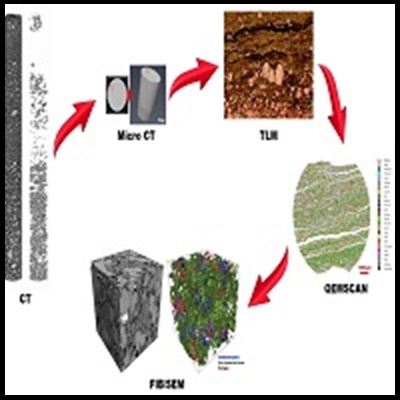Integral evaluation of unconventional reservoir properties from multi-scale imaging and analysis
Evaluación integral de propiedades de yacimientos no convencionales a partir de imágenes y análisis a diferentes escalas
DOI:
https://doi.org/10.24054/bistua.v22i1.2551Keywords:
Unconventional reservoirs; Multi-scale imaging; Analytical tecniques; Petrophysical properties; Reserves estimatesAbstract
Since the production of conventional oil and gas is declining while costs are increasing, in recent years focus of interest directed toward unconventional reservoirs. The integral evaluation of unconventional reservoirs is based on multi-scale imaging and analysis, which includes X-ray Computed Tomography, X-ray Micro-Computed Tomography, Quantitative Evaluation of Minerals by Scanning Electron Microscopy and Focused Ion Beam Scanning Electron Microscopy, which can be integrated each other to provide a dataset that can assist in understanding the rock properties and can be used for understanding the rock properties based on their integral evaluation to improve reserves estimates and production efficiency, and mitigate all the associated risks. In this work, we highlight a mineralogy workflow for integral evaluation of unconventional reservoirs, involves imaging and analysis of unconventional rocks like tight sandstones, carbonates and shales, to study effects of clay, minerals and diagenetic processes and to carry out fast and accurate computations of rock properties, such as porosity and pore geometry (pore size, connectivity and distributions), absolute and relative permeability, fracture network, and flow simulations.
Downloads
References
F. A. Anifowose, J. Labadin, A. Abdulraheem, Ensemble machine learning: An untapped modeling paradigm for petroleum reservoir characterization. J. Petrol. Sci. Eng. 151 (2017) 480-487.
H. Mehrabia, B. Esrafili-Dizajia, E. Hajikazemib, B. Noorib, H. Mohammad-Rezaeib, Reservoir characterization of the Burgan Formation in northwestern Persian Gulf. J. Petrol. Sci. Eng. 174 (2019) 328–350.
A. Satter, G. M. Iqbal, Reservoir Engineering: The Fundamentals, Simulation, and Management of Conventional and Unconventional Recoveries, in: A. Satter and G. M. Iqbal (Eds.), Reservoir Engineering, Elsevier Science Publishers, New York, 2015, 486p.
A. M. Al-Marzouq, T. M. Al-Ghamdi, S. Koronfol, M. R. Dernaika, J. Walls, Shale Gas Characterization and Property Determination by Digital Rock Physics. Saudi Aramco J. Technol. (2014) 2-13.
J. Martínez-Martínez, N., Fusi, J. J. Galiana-Merino, D. Benavente, G. B Crosta, Ultrasonic and X-ray computed tomography characterization of progressive fracture damage in low-porous carbonate rocks. Eng. Geol. 200 (2016) 47-57.
Y. Han, D. Hu, L. Matzar, Numerical computation of elastic properties for porous rocks based on CT-scanned images using direct mapping method. J. Petrol. Sci. Eng. 122 (2014) 346-353.
W. De Boever, H. Derluyn, D. Van Loo, L. Van Hoorebeke, V. Cnudde, Data-fusion of high resolution X-ray CT, SEM and EDS for 3D and pseudo-3D chemical and structural characterization of sandstone. Micron 74 (2015) 15-21.
R. M. Slatt, N. R. O’Brien, Pore types in the Barnett and Woodford gas shales: contribution to understanding gas storage and migration pathways in fine-grained rocks. AAPG Bull. 95(12) (2011) 2017–2030.
M. E. Curtis, B. J. Cardott, C. H. Sondergeld, Ch. S. Rai, Development of organic porosity in the Woodford Shale with increasing thermal maturity. Int. J. Coal Geol. 103 (2012) 26-31.
W. R. Goodall, P. J. Scales, An overview of the advantages and disadvantages of the determination of gold mineralogy by automated mineralogy. Miner. Eng. 20(5) (2007) 506-517.
K. F. E. Anderson, F. Wall, G. K. Rollinson, Ch. J. Moon, Quantitative mineralogical and chemical assessment of the Nkout iron ore deposit, Southern Cameroon. Ore Geol. Rev. 62 (2014) 25-39.
M. Dieterich, B. Kutchko, A. Goodman, Characterization of Marcellus Shale and Huntersville Chert before and after exposure to hydraulic fracturing fluid via feature relocation using field-emission scanning electron microscopy. Fuel 182 (2016) 227-235.
Sh. Zhou, G. Yan, H. Xue, W. Guo, X. Li, 2D and 3D nanopore characterization of gas shale in Longmaxi formation based on FIB-SEM. Mar. Petrol. Geol. 73 (2016) 174-180.
S. L., Wellington, H. J. Vinegar, X-Ray computerized tomography. J. Petrol. Technol. 39(8) (1987) 885-898.
J. D. Walls, S. W. Sinclair, Eagle Ford Shale Reservoir. Properties from Digital Rock Physics. First Break 29(6) (2011) 97-101.
M. Ahmad, Petrophysical and mineralogical evaluation of shale gas reservoirs (A Cooper Basin Case Study). PhD Thesis, The University of Adelaide, 2014.
R. G. Loucks, R. M. Reed, S. C. Ruppel, U. Hammes, Preliminary classification of matrix pores
in mudrocks. Trans. Gulf Coast Assoc. Geol. Soc. 60 (2010) 435–441.
M. A. Sayed, G. A. Al-Muntasheri, F. Liang, Development of shale reservoirs: Knowledge gained from developments in North America. J. Petrol. Sci. Eng. 157 (2017) 164–186.

Additional Files
Published
Issue
Section
License
Copyright (c) 2024 © Autores; Licencia Universidad de Pamplona

This work is licensed under a Creative Commons Attribution-NonCommercial-NoDerivatives 4.0 International License.
© Autores; Licencia Universidad de Pamplona





